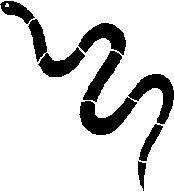
The venom of the cottonmouth is
hemotoxic. This means that the venom breaks down and
destroys blood cells and other tissues and reduces
the ability of blood to coagulate or clot. This
results in a hemorrhage throughout any portion of
the circulatory system that has been penetrated by
the venom.


